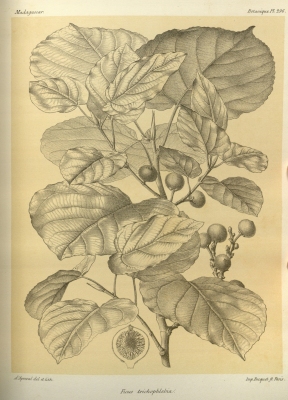Ficus tiliifolia
Baker
Moraceae
Ficus pulvinifera Baker
Ficus sphaerophylla Baker
Ficus trichophlebia Baker
Common Name:
General Information
Ficus tiliifolia is a tree growing up to 20 metres tall[
570- Title
- Adansonia Vol. 8.
- Publication
- Bulletin du Muséum National d'Histoire Naturelle Tome 8
- Author
-
- Website
- http://www.biodiversitylibrary.org
- Publisher
- Museum National d'Histoire Naturelle; Paris.
- Year
- 1986
- ISBN
-
- Description
- Contains, amongst others, a treatment of the genus Ficus (Figs) in Madagascar and Mauritius. It can be downloadd from the Internet.
].
The tree is occasionally cultivated in eastern Madagascar as a source of fibre and edible fruits[
].
Known Hazards
None known
Botanical References
570- Title
- Adansonia Vol. 8.
- Publication
- Bulletin du Muséum National d'Histoire Naturelle Tome 8
- Author
-
- Website
- http://www.biodiversitylibrary.org
- Publisher
- Museum National d'Histoire Naturelle; Paris.
- Year
- 1986
- ISBN
-
- Description
- Contains, amongst others, a treatment of the genus Ficus (Figs) in Madagascar and Mauritius. It can be downloadd from the Internet.
Range
Africa - northern and central Madagascar, Comores
Habitat
Forests, at elevations up to 1,700 metres[
570- Title
- Adansonia Vol. 8.
- Publication
- Bulletin du Muséum National d'Histoire Naturelle Tome 8
- Author
-
- Website
- http://www.biodiversitylibrary.org
- Publisher
- Museum National d'Histoire Naturelle; Paris.
- Year
- 1986
- ISBN
-
- Description
- Contains, amongst others, a treatment of the genus Ficus (Figs) in Madagascar and Mauritius. It can be downloadd from the Internet.
].
Properties
| Edibility Rating |      |
| Other Uses Rating |      |
| Habit | Tree |
| Height | 15.00 m |
| Pollinators | Wasps |
| Cultivation Status | Cultivated, Wild |
Cultivation Details
Fig trees have a unique form of fertilization, each species relying on a single, highly specialized species of wasp that is itself totaly dependant upon that fig species in order to breed. The trees produce three types of flower; male, a long-styled female and a short-styled female flower, often called the gall flower. All three types of flower are contained within the structure we usually think of as the fruit.
The female fig wasp enters a fig and lays its eggs on the short styled female flowers while pollinating the long styled female flowers. Wingless male fig wasps emerge first, inseminate the emerging females and then bore exit tunnels out of the fig for the winged females. Females emerge, collect pollen from the male flowers and fly off in search of figs whose female flowers are receptive. In order to support a population of its pollinator, individuals of a Ficus spp. must flower asynchronously. A population must exceed a critical minimum size to ensure that at any time of the year at least some plants have overlap of emmission and reception of fig wasps. Without this temporal overlap the short-lived pollinator wasps will go locally extinct[
413- Title
- Global Invasive Species Database
- Publication
-
- Author
-
- Website
- http://www.issg.org/database/welcome/
- Publisher
-
- Year
- 0
- ISBN
-
- Description
- Very detailed information on almost 400 species (with more being added) of plants that have become weeds in areas outside their native range.
].
Edible Uses
Fruit - raw[
]. The subglobose fruit is 15 - 25mm in diameter[
570- Title
- Adansonia Vol. 8.
- Publication
- Bulletin du Muséum National d'Histoire Naturelle Tome 8
- Author
-
- Website
- http://www.biodiversitylibrary.org
- Publisher
- Museum National d'Histoire Naturelle; Paris.
- Year
- 1986
- ISBN
-
- Description
- Contains, amongst others, a treatment of the genus Ficus (Figs) in Madagascar and Mauritius. It can be downloadd from the Internet.
].
Medicinal
None known
Other Uses
A fibre obtained from the bark is used to make textiles and nets[
].
Propagation
Seed -
If you have any useful information about this plant, please leave a comment. Comments have to be approved before they are shown here.






 Useful Tropical Plants Database 2014 by
Ken Fern,
web interface by
Ajna Fern
with help from
Richard Morris.
Useful Tropical Plants Database 2014 by
Ken Fern,
web interface by
Ajna Fern
with help from
Richard Morris.